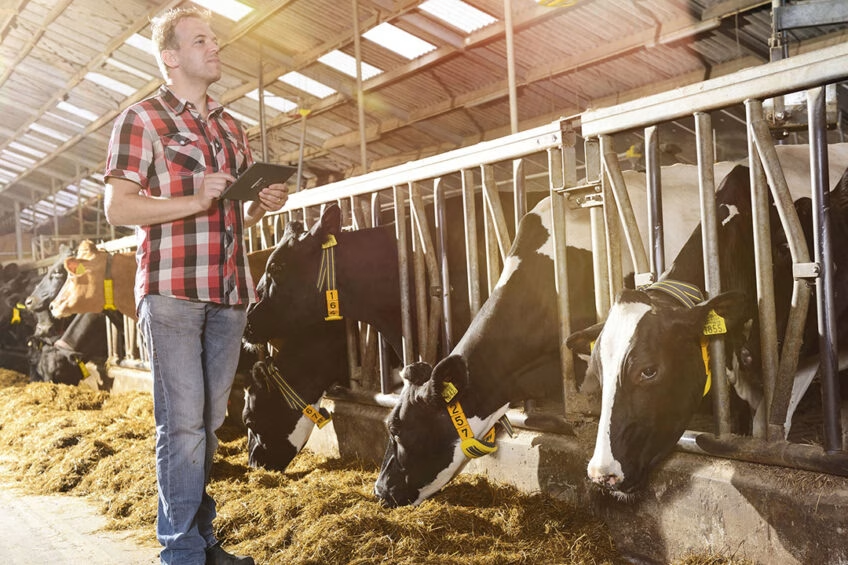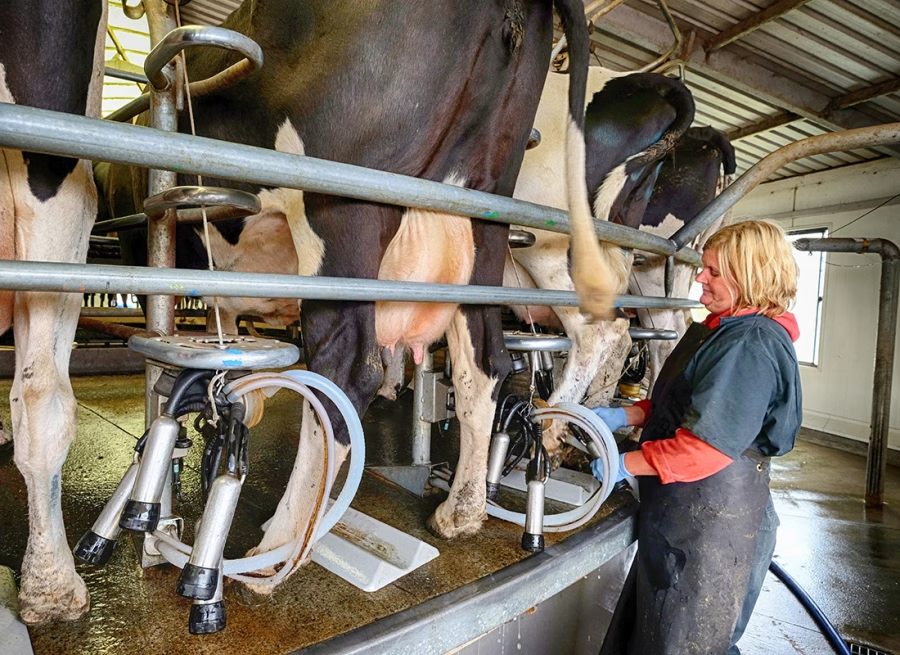Learn how advanced data tracking software on dairy farms can boost health monitoring and decision-making during Avian Flu outbreaks. Ready to improve your farm’s efficiency?

As dairy farms undergo a silent revolution, grappling with the highly pathogenic avian influenza (HPAI) crisis, the role of data monitoring and management tools becomes increasingly crucial. These tools provide dairy farmers with reassurance and confidence in their operations and pave the way for further technological advancements. This paper will discuss the importance of these technical developments, especially in light of the HPAI crisis, and the potential benefits that further advancements can bring, enhancing operational effectiveness and animal care.
Recent HPAI events emphasize how critical data systems are. More efficient reactions and faster diagnosis follow from farmers monitoring and managing livestock with unheard-of precision made possible by sophisticated technologies. Modern dairy production depends on including sophisticated data monitoring.
Data-driven decisions are pivotal in swiftly isolating a viral epidemic and preventing widespread illnesses and financial losses. We will explore how tracking tools aid in monitoring cattle health, ensuring protocol compliance, and optimizing feed economy. Emerging technologies like IoT devices and machine learning instill hope and optimism in dairy farmers, promising a more efficient and user-friendly disease management system.
Understanding and implementing these technologies is not just beneficial; it’s essential for farmers striving to enhance herd health and agricultural output. The financial implications for the dairy sector are significant, and meeting customer expectations for transparency and animal welfare is necessary. The solutions are within reach, and the potential benefits are substantial.
From Poultry to Dairy: Navigating the Ripple Effects of HPAI with Data-Driven Precision
The highly pathogenic avian influenza (HPAI) devastated poultry. Its knock-on effects also reached dairy farms and the more general agriculture sector. Although dairy animals are not immediately affected, the linked character of farming makes vigilance essential for dairy producers.
HPAI outbreaks, especially those caused by the H5 and H7 viruses, require strict biosecurity and monitoring. These outbreaks have resulted in declining consumer trust, poultry losses, and trade restrictions that have caused financial losses. Dairy farms have a more significant agricultural effect, so they must be proactive even if they are not directly impacted.
Recent HPAI events highlight the need for thorough data collection and real-time observation. Modern herd management systems provide exact monitoring and movement of animals, enabling early identification and confinement. This technology guarantees quick identification of odd health trends, reducing the effect of diseases.
The cooperation between farmers and software developers emphasizes the requirement of user-friendly interfaces and practical data. Accessible data entering and readily available, reliable information enable farmers to make timely choices based on knowledge. Along with robust biosecurity policies, improving these digital technologies will safeguard animal health and strengthen agricultural operations against the next pandemic.
Data Tracking: Revolutionizing Dairy Farm Management for Enhanced Efficiency and Animal Health
Data tracking transforms dairy farm management by improving animal health monitoring, honing decision-making, and increasing farm efficiency. Gathering and evaluating data using sensors and software may holistically approach herd management.
One significant advantage is careful medical attention. Comprehensive records of health indicators like rumination, milk production, and mobility patterns enable early identification of health problems. As demonstrated with HPAI, early discovery enables quick treatment and reduces illness transmission across the herd.
Moreover, data monitoring enhances decision-making. Real-time and historical data access helps farmers decide on general management, feeding, and breeding policies. By exposing milk production patterns connected to feeding schedules, analytics helps to optimize diets for the highest output. For best efficacy, data-driven insights may direct treatment and immunization scheduling.
Data tracking technologies improve agricultural efficiency overall. Real-time monitoring and automation simplify labor-intensive operations so farmers may concentrate on more critical chores. Standardized data collection guarantees constant procedure adherence and helps decrease mistakes. Combining many data sources into one system helps provide flawless operations and coordination across agricultural activities.
Data tracking is crucial for dairy farm management. Improved health monitoring, decision-making, and efficiency enable farmers to run contemporary dairy operations precisely and effectively.
Empowering Farmers with Accessible and Actionable Data: Practical Tips for Maximizing Data Utility
Ensuring data is accessible and actionable to fully use data monitoring in dairy production. These valuable pointers help to increase data usefulness.:
- One of the critical aspects of effective data monitoring is the use of user-friendly interfaces. By selecting intuitive software, data entry and retrieval become easy tasks for farm staff, ensuring that the data is accessible and actionable for everyone involved in the dairy production process. Mobile Apps: Mobile apps record data in real time, minimizing errors and saving time.
- Regular Training: Train staff regularly to use data tools and understand their importance.
- Automation: Automate tasks like vaccination notifications and health checks to ensure consistency.
- Data Reviews: Hold regular data review sessions to spot trends and areas for improvement.
- Customizable Reports: Use systems that allow custom reports and dashboards to meet specific farm needs.
- Data-Driven Decisions: Base decisions on empirical data rather than intuition to efficiently predict trends and allocate resources.
Dairy farms may make educated choices, maximize operations, and improve animal care by stressing user-friendliness, real-time data input, regular training, automation, frequent data reviews, configurable reporting, and a data-driven attitude.
Bridging the Information Gap: Using Digital Tools to Enhance Transparency and Consumer Trust
On farms, openness and customer confidence depend on the integration and advantages of communicating sophisticated technologies. Emphasizing the farm’s dedication to animal care, sustainability, and food safety closes the distance between growers and customers.
Practical means for this communication include digital channels like a farm’s website, social media, and QR codes on packaging. Frequent updates, blog entries, and real-time data exchange help to powerfully show technology developments.
A farm’s website may provide real-time representations of animal health and productivity data, such as rumination durations and milk output. Live feeds and video tours improve openness, enabling customers to make physical sense of processes.
Fostering enduring customer confidence and loyalty will depend on farms adopting new technology and embracing these communication techniques.
The Future of Dairy Farming: Advancements in Technology Promising Enhanced Animal Care and Efficiency
With new technology poised to transform animal care and farm efficiency, dairy farming looks bright. Machine learning, artificial intelligence (AI), and improved camera systems are critical to this shift- observing animal health and behavior.
Machine learning and artificial intelligence excel at analyzing vast data sets, which can assist farmers in making choices. Tracking data from milking machines, sensors, and environmental monitors, these systems may spot patterns and project health problems. AI can, for example, identify minor variations in milk supply or eating habits, indicating possible diseases early on and enabling quick treatments.
Computer vision cameras are revolutionizing herd surveillance by autonomously assessing cow activity and bodily condition. This real-time input enables quick resolution of lameness or mobility difficulties, lowering the long-term health risk. Furthermore, these cameras can track feeding habits, guaranteeing that every animal eats right—a necessary condition for the herd’s general health.
The Internet of Things (IoT) improves these sophisticated technologies. It collects and transmits real-time data to give a dynamic picture of agricultural operations. When integrated with artificial intelligence and machine learning, IoT can maximize feeding, milking, and breeding operations according to individual requirements. Customizing helps agricultural efficiency and animal welfare.
As technology develops, smaller and larger farms should find these improvements more accessible, and the expenses and complexity of implementation should be lower. This will enable innovative technologies to be more widely distributed, guaranteeing better efficiency and animal welfare advantages. Ultimately, dairy farming will evolve with more creative approaches emphasizing health and quality, redefining industry norms.
The Bottom Line
Dairy production must use data monitoring systems to address highly pathogenic avian influenza (HPAI) issues. Data-driven technology improves herd health, efficiency, and profitability, strengthening dairy operations. Individual cow data is crucial for detecting health problems, monitoring movements, and guaranteeing procedure adherence. Rumination monitoring systems help farmers make wise choices, lower mistakes, and improve animal welfare. Their real-time insights help simplify agricultural operations and efficiently use resources and labor. By using technology that provides actionable information, dairy farms may proactively manage health concerns, increase herd production, and help ensure food security. Our analysis shows how technology innovation benefits real-world farm management, establishing data as the pillar of animal welfare and agricultural effectiveness. Farmers have to welcome new instruments for technology, educate their employees, and build a continuously improving culture. Doing this will protect our cows from dangers such as HPAI and open the path for a more robust and profitable dairy sector.
Key Takeaways:
- Data tracking software provides real-time monitoring of livestock health, improving early detection and management of diseases such as HPAI.
- Protocols and record-keeping can be standardized and streamlined, ensuring consistency in animal care practices across different farm sites.
- Enhanced data analytics enable more informed decision-making, from individual animal health interventions to broader farm management strategies.
- Technology such as mobile apps and wearable devices for livestock simplifies data entry and increases the accuracy of recorded information.
- Collaboration between data-centric companies like Dairy One and BovaSync ensures comprehensive solutions for dairy farmers, integrating various data sources into a cohesive management system.
- Advanced technologies, including machine learning and automation, are poised to further revolutionize dairy farming by providing predictive insights and optimizing resource allocation.
- Using data to enhance transparency can help build consumer trust and communicate the high standards of animal care practiced on modern dairy farms.
Summary:
The integration of advanced tracking software and data-driven methodologies in dairy farming not only helps address pressing concerns such as the spread of avian influenza but also enhances overall farm management by improving animal health monitoring, optimizing nutrition, and increasing operational efficiency. With the ongoing development and adoption of new technologies like machine learning, IoT-based monitoring systems, and real-time data analytics, the future of dairy farming promises even greater advancements in animal care and productivity, offering farmers actionable insights to make informed decisions and foster consumer trust.












